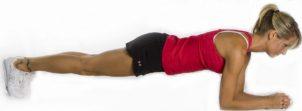Up-Leveling Your Core Training? Four Things You Need to Know!
 ‘Tis the season. Look around and the magazines are full of headlines announcing the looming arrival of bikini season. Yay. If you’re like most women, the thought of trying on a new bathing suit, (or new bike shorts, according to a mountain biker friend) is
‘Tis the season. Look around and the magazines are full of headlines announcing the looming arrival of bikini season. Yay. If you’re like most women, the thought of trying on a new bathing suit, (or new bike shorts, according to a mountain biker friend) is
about as much fun as chewing glass. Nothing like fluorescent lighting, 3 way mirrors and and a tiny scrap of lycra to make you feel like a million bucks. (Insert groan here).
And so, with the dual onslaught of headlines like “Get your bikini body in 3 weeks,” and the fitness industry pouring on the “Power Core – Get Your Flat Belly Here” classes, we often get hooked into thinking that a little “core blasting” will do the trick.
And you know what? For some, it might.
But let me preface this article by saying this: I believe that the purpose of core specific training is to improve overall stability and integrated function in the whole body, creating conditions where the body has the capacity to respond and react with agility, mobility, strength and power. The fact that the physique typically takes on a pleasing aesthetic as a result is a plus, not the raison d’etre.
A well functioning core is essential for efficient, coordinated movement, and for effective structural support. You can’t train the core the way you’d train a thigh muscle or a bicep. The functions of these structures are DIFFERENT, so the way to strengthen them is different. Even the things that constitute “strength” in these structures is different. In a thigh muscle – you want that muscle to have the ability to contract HARD and often. Deep core musculature is endurance muscle – it needs to be able to stay engaged at a low to moderate level for a long time. Half the battle is making sure you are actually engaging the right muscles, and then that you are able to control how them well in motion.
Too often, I see people plunged into situations in “core” classes where they are clearly not able to access deep support, so they end up “blasting” all kinds of compensatory muscle patterns – instead of actually working the core. And when a pattern is dysfunctional, you absolutely don’t want to continue to reinforce it, and add more load! When you do – bad things happen. Maybe not today, but eventually, they will happen.
If you’re in the process of trying to uplevel your core training, here are a few things to be aware of:
1. If your training focuses mostly on strength of individual muscles:
If you’re working abdominal muscles, then back muscles, etc., then you may not be getting the full benefit of core training. Individual core muscles can’t do the job of creating stability all by themselves. Core stability is ONLY created by efficient coordination & control of these muscles with each other and with other structures. In fact, too much strength in one or two muscles may actually inhibit others from working well, increasing the likelihood of uncoordinated movement (at best), and injury (at worst). The problem is, you will feel “strong” and you likely won’t notice the deficiency until something goes wrong, e.g.: a bulging or ruptured disc, incontinence issues, reduced cardiovascular function or other problems.
 2. If your training is not about movement:
2. If your training is not about movement:
Recent trends in core training lean towards using planks and static exercises for strengthening the core. These are effective exercises for training access and endurance in the core – in static positions. They may not be effective for training core stability in motion. To be truly effective, your core training needs to include actions that challenge your stability in as many planes of motion as possible. If you want to start with static training to make sure you can access the right stuff – great. But make sure you progress to action!
3. If it’s all about the burn:
Before you challenge strength & endurance – make sure you have CONTROL! You absolutely do not want to load and reinforce bad motor control patterns. Pay attention to how things feel. Can you access the full length of your spine, with freedom in the legs and shoulders? Is your butt clenched the whole time? Can you breathe well? If not, you’ve likely lost some component of your core and are compensating somewhere else. Slow down, back off and get some help figuring out what needs better support.
4. If your core training is ALL ABOUT THE ABDOMINALS:
Your abdominal muscles are not the whole story. You want to make sure your core training includes your back, your pelvic floor and your BREATH too! The way these pieces coordinate, working together and with other structures like your deep hip flexors will determine how well you can control your spine, and your pelvis – and by extension, the whole body. Don’t get caught just blasting abs if your goal is support.
If you’d like to take a deep dive into a truly functional core, check out Moving Spirit’s Pilates and Integrated Movement programs in our Getting Started Guide, or book an Introductory Private Training Package today.
About Susannah Steers
 Susannah is a Pilates and Integrated Movement Specialist, and owner of Moving Spirit. Through movement teaching, speaking, and facilitating workshops, she supports people in creating movement practices that promote fitness from the inside out. Susannah co-hosts The Small Conversations for a Better World podcast; an interview based podcast engaging in conversations about health that can spark positive change in individuals, families, communities and around the world.
Susannah is a Pilates and Integrated Movement Specialist, and owner of Moving Spirit. Through movement teaching, speaking, and facilitating workshops, she supports people in creating movement practices that promote fitness from the inside out. Susannah co-hosts The Small Conversations for a Better World podcast; an interview based podcast engaging in conversations about health that can spark positive change in individuals, families, communities and around the world.
